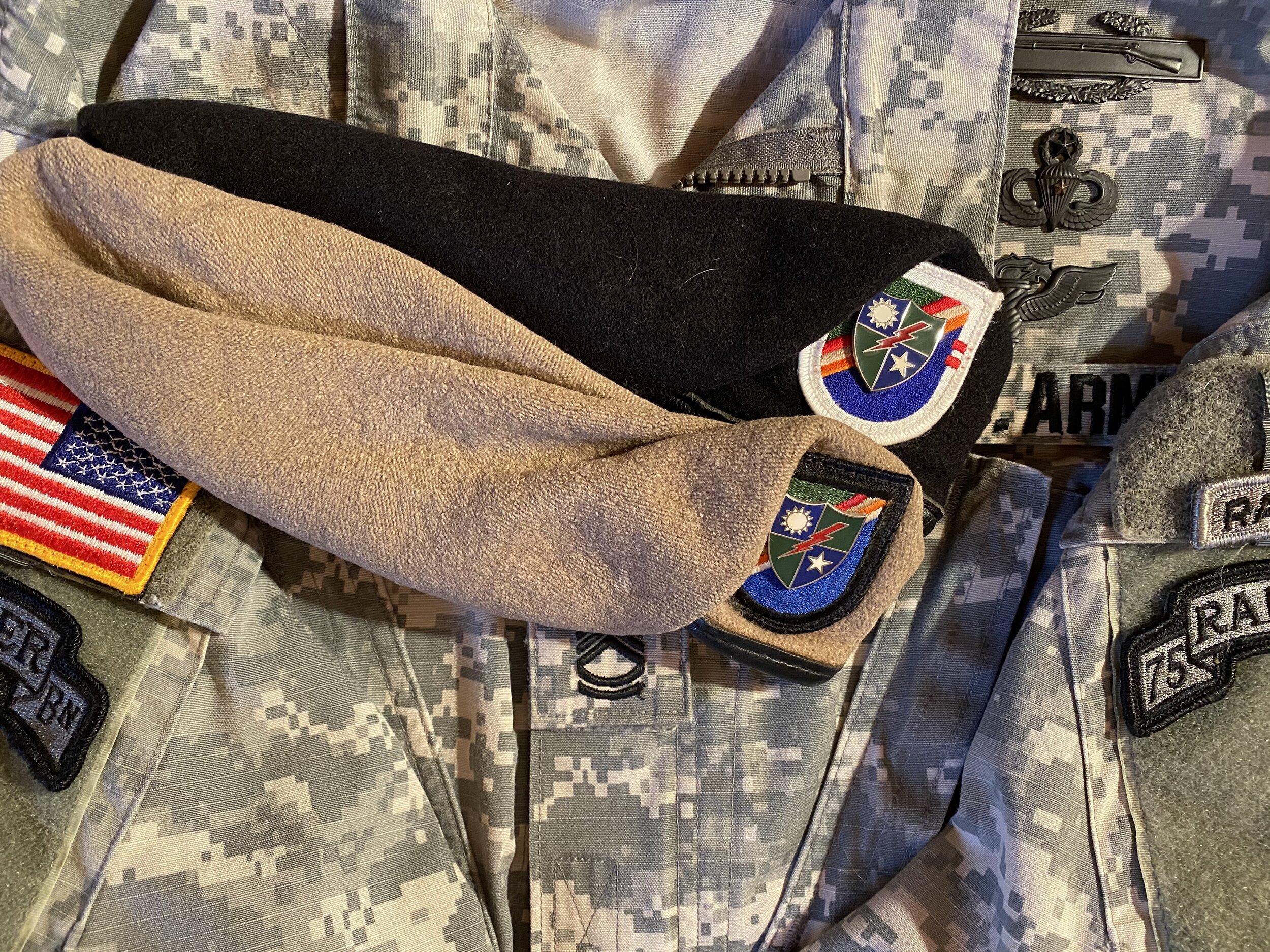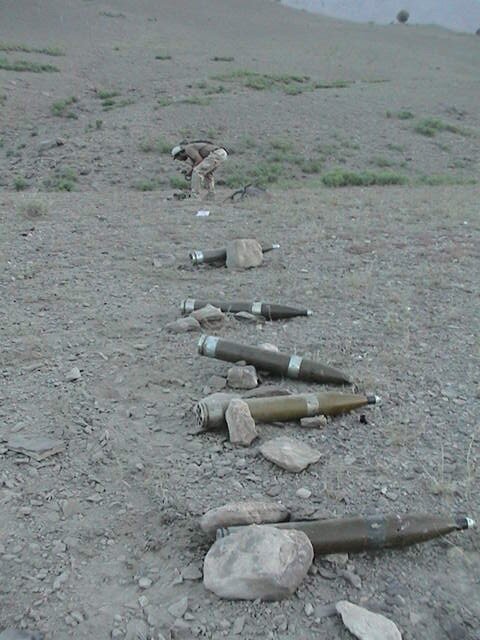October 7, 1997, 3:00 am. I curled up on a bench under a mannequin bearing two 3rd Ranger Battalion scrolls, a Ranger Tab, Master Parachutist Badge with a mustard stain, Combat Infantryman’s Badge (CIB), and Pathfinder Badge. Resting on top, like a crown of glory, was the coveted Black Beret of the US Army Rangers. This was the standard for all Infantrymen to aspire to. This was the symbol of excellence.
I had left Oakland the day before, arrived in Atlanta late, and caught a bus deep through the Georgia pines to Ft. Benning’s Sand Hill for Basic Training and Infantry School.
Slipping into sleep, I dreamt of what it would be like to wear that uniform. Perhaps someday. I knew it would take an awful lot to earn it, and I was willing to pay in blood and toil for that Black Beret.
Four years later, and 12 weeks before 9/11/01, I stood in the formation of the 2nd Ranger Battalion, black beret on my brow, tan beret in my pocket. I was reluctant to change, and completely unaware of the imminent cultural shift that awaited.
The black beret was an emblem of excellence worn only by the Rangers until June 14, 2000, when General Eric Shinseki, Chief of Staff of the Army, determined it would become a universal symbol of excellence for the entire U.S. Army.
It felt like a slap in the face to all of us who suffered at Cole Range, under the torture of the Ranger Indoctrination Program (RIP), a 3 week program to weed out those not completely committed for service in the Rangers.
“Earned not issued!” We shouted in outrage.
When we saw a black beret, we knew a lot about the man who wore it, and what it took to earn it. Now, the entire Army was about to be issued our distinctive headgear. To say that some of us were upset would be putting it very lightly. Thankfully, our superiors took a more thoughtful approach, advocating for a shift that would honor the heritage of the unit and retain the uniqueness of serving in the Rangers.
In March of 2001, the Command of the Rangers petitioned for and received approval to change our headgear to the tan beret.
"The Ranger tan beret will represent for the Ranger of the 21st century what the black beret represented -- a unit that leads the way in our conventional and special operations forces," P.K. Keen said, then Commander of the 75th Ranger Regiment.
He had no way of understanding just how accurate his statement was. None of us did.
The black beret was a hard won cultural symbol, and it was hard to let go of, but the change to tan turned out to be symbolic of an even greater shift in the culture and capabilities of the Rangers. Before our new tan berets had the chance to form to our closely shaved heads, the world shifted seismically when those towers fell on 9/11.
The 75th Ranger Regiment deployed immediately after the attack and became the most continuously deployed unit in the GWOT.
We learned quickly that this would not be like the Ranger missions of the 20th century. We were in a long, hard fight, against an enemy unlike those of the recent past. The days of the Urgent Fury strike were gone. We were now committed to protracted conflict with a persistent and elusive enemy, and we had to adapt to win.
For starters, the rules had completely changed, if there were any at all. Our enemy didn't stand in formations, didn't wear uniforms, didn’t fight us head on, and seemed to evolve daily.
We could close with and destroy any enemy toe to toe, but we were chasing shadows in the day and dodging rockets in the night. They knew they couldn’t win in a direct fire engagement, so they didn’t even try. They planted bombs in roads, murdered indigenous allies in their homes, and manipulated the human network with ideology and intimidation to stay one step ahead of us.
2002. Afghanistan. Enemy rockets on a time delay firing device found pointed at our safe house before they detonated.
The first few years of the war were a wake up call. The world no longer needed the 75th Ranger Regiment of the 80’s and the 90’s that served with excellence in Grenada, Panama, and Somalia. The world needed today’s US Army Rangers that remain decisively engaged in the Global War on Terror.
Our barrel-chested, 30 mile ruck marching, hard as nails, premier light infantry and special operations force in the Army had to become more agile, more professional, and more proficient to meet the shifting needs of the asymmetrical fight. It wasn’t easy, but it was intentional at every echelon of leadership.
We changed the way we looked, the way we dressed, the way we assessed and selected candidates for the Rangers, and the way we trained. But our mission, our values, our creed, and our commitment to the unit remained, and held us together while we evolved to become more lethal in the midst of brutal war.
I am reminded of this today as leaders and organizations across our country wrestle with the cultural shifts required to continue their missions in the post-pandemic world. Whether we like it or not, the world has fundamentally changed and we need to change with it. Simply adjusting our tactics may not be enough. For many of us, it might be time for cultural or structural changes.
Change isn’t an indictment of the past. Different doesn’t imply wrong. Different doesn’t necessarily imply better; different implies different.
There’s nothing wrong with who we’ve been, it’s just time to become who the mission and the moment needs us to be.
A leader’s first job is to see the world as it truly is, not as it was or how we wish it were. And to accept it. If we can do that, then we can be clear and intentional in how we transform to meet the needs of today, just like the Rangers have been doing for over three hundred years.
Photo Credit: US Army.
The beautiful thing about culture is that we get to cast a vote. Culture doesn’t create people. People create culture. The leaders and members of every organization determine the culture, either by accident or on purpose. We strongly recommend you do the latter. We hope you will take this opportunity to assess and re-shape the aspects of your culture that no longer serve you.
It took 50 years for that black beret to become the Ranger symbol of excellence. Fifty years of missions that called for Rangers to “move further, faster, and fight harder than any other Soldier.” Two decades this side of exchanging our black berets for tan, our story has only strengthened. Though it was hard to let go of the past, it was an honor to participate in building the future - the next chapter of an already storied lineage that dates back to the 1700’s.
Regardless of the headgear, the Rangers remain the most lethal, premier raid force in the Army today after three centuries of innovation from the tip of the spear.
Culture and capabilities must evolve to ensure relevance and effectiveness. Evolving to the needs of the time is a sign of strength. Holding on to the past is a sign of fear (and that makes sense). Change is scary, and costs something from everyone.
Those leaders who reach back to the strength of the past while transforming for the needs of the future, are the ones who will successfully move an organization forward. Those who guard the old ways will be left behind.
June 2, 2006. My last day in the ranks of the 75th Ranger Regiment came and went like any other Ranger. I stood in that formation proud to have been a small part of such a huge story.
My uniform that day was identical to the mannequin on Sand Hill nine years before, save for two key differences: the scroll on my right shoulder bore the marks of the 2nd Ranger Battalion, and the beret that was proudly perched on my head was tan.
RLTW,
Brandon
June 2006. Saying goodbye to the 75th Ranger Regiment.





